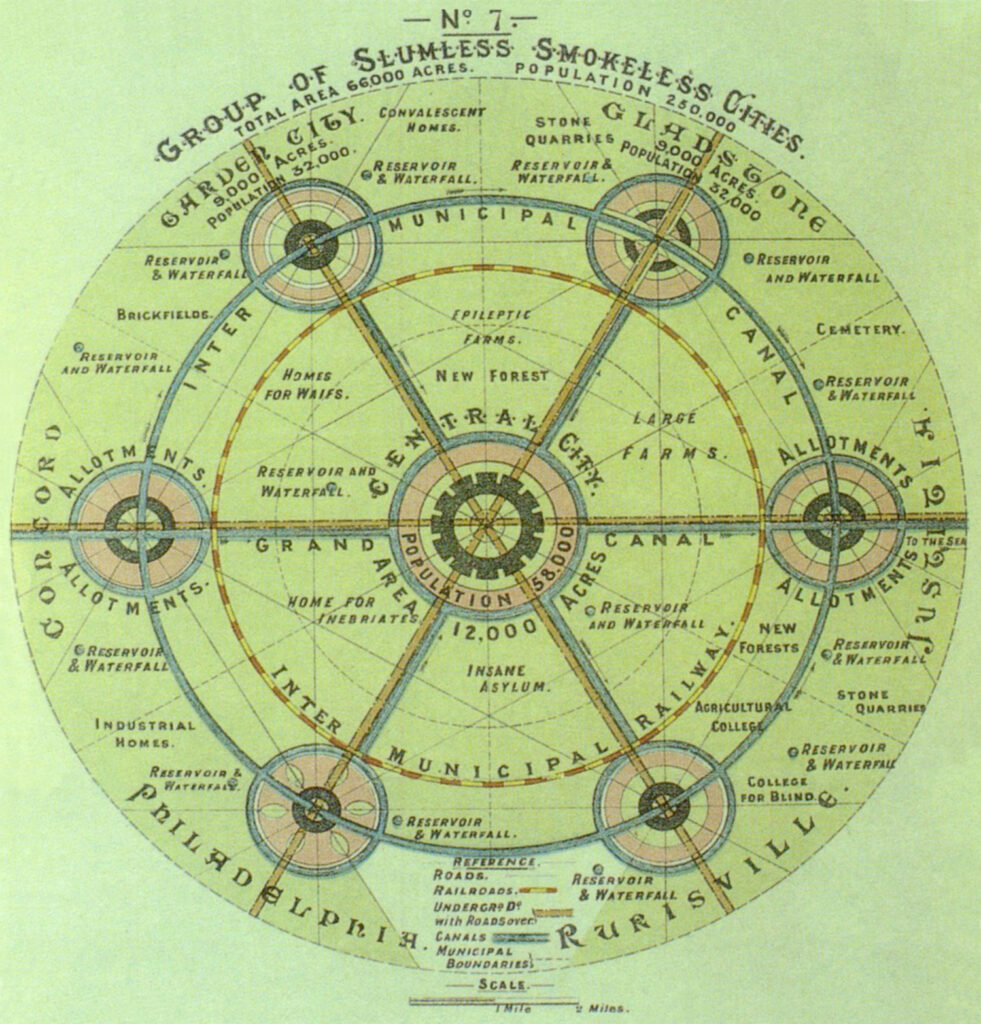Whilst studying this week’s reading Ecological Design by Sim Van Der Ryn & Stuart Cowan, there was a section in which they explored the history & background to ecological design – mentioning precedents such as William Morris’ Arts & Crafts Movement, Dymaxion houses, Frank Lloyd Wright’s organic architecture & more. I was especially intrigued by Ebenezer Howard’s garden city concept.
“Garden Cities” emerged in 1898 through Howard’s book To Morrow: A Peaceful Path to Real Reform. The concept was a visionary solution to the overcrowded & polluted cities of the Industrial Revolution. The main aims of the cities were to combine urban & rural benefits – blending vibrancies of cities with tranquility & health benefits of the countryside. He mainly achieved this by including “greenbelts” around these communities – a small area of open space to preserve land around cities for agriculture & access to nature.

Ebenezer Howard’s vision for a group of “Smokeless, Slumless Cities”, 1898.
 The concept was introduced to Letchworth in 1903, becoming the first garden city to be developed. It featured planned residential neighbourhoods with communal green spaces & agricultural land. This continues to serve as a case study for more sustainable planning. Eventually, Welwyn Garden City was developed in 1920, this time combining Howard’s vision with more modern urban elements (specifically transport).
The concept was introduced to Letchworth in 1903, becoming the first garden city to be developed. It featured planned residential neighbourhoods with communal green spaces & agricultural land. This continues to serve as a case study for more sustainable planning. Eventually, Welwyn Garden City was developed in 1920, this time combining Howard’s vision with more modern urban elements (specifically transport).
The three “magnets” of Garden Cities (1898), Ebenezer Howard.

Despite the many ambitions that garden cities housed, there were a lot of challenges within the project. Housing in the garden cities eventually became unaffordable for workers, which is a large problem still prevalent today. Urban areas with high population densities struggled to apply the expansive designs that Howard envisioned too, which raises the question about how to adapt these elements in such small spaces. As time went on, cities across the country increased their population, so the success of this concept got more & more questionable.
(Pictured right) Sketch of Welwyn Garden City, Natalie Foster.
The concepts seen in Howard’s vision are still echoed today – green belts & urban growth speficially have played a large role in preventing urban sprawl, seen in large cities such as London. These areas preserve ecosystems while limiting expansion of urban spaces & gives people a space to relax & take a break from the business of the city itself. Sustainable practices are a lot more common nowadays too, the incorporation of parks, bike lines & pedestrian-friendly streets reflect Howard’s vision for a more human-centric environment.
As there is still so much to consider in the present if we want to introduce this type of planning into our own environments, there are ways to possibly modernize the garden city vision. Vertical green spaces could make green spaces a lot more accessable & viable in densely populated areas, rooftop gardens are already quite popular in places such as New York, Tokyo & Chicago. Technology is also something that has improved significantly since the garden city concept was introduced, helping us immensely over the years through energy efficiency practices & improved public transport.
Letchworth Garden City (2023), Loveletchworth.com
In short, the garden city concept was a groundbreaking idea in the early 1900’s as sustainability was still a relatively new practice. I believe that we can still use this urban planning as a foundation for future improvements to cities, our technological advancements have changed our streets dramatically over the past century, so with tweaking this concept can help improve our environment greatly. I find this concept really interesting, I love the layout of the garden city & I find it amazing that the cities in Letchworth & Welwyn are pretty much still the same.
___
Van and Cowan, S. (1996). Ecological Design.
Britannica (2019). Garden city | urban planning. In: Encyclopædia Britannica. [online] Available at: https://www.britannica.com/topic/garden-city-urban-planning.
Wikipedia Contributors (2019). Garden city movement. [online] Wikipedia. Available at: https://en.wikipedia.org/wiki/Garden_city_movement.
Wainwright, O. (2014). The garden city movement: from Ebenezer to Ebbsfleet. The Guardian. [online] 17 Mar. Available at: https://www.theguardian.com/artanddesign/architecture-design-blog/2014/mar/17/ebbsfleet-garden-city-george-osborne.
Angermann, M. (2022). Garden City Movement: History, Examples and Criticism. [online] Utopia. Available at: https://utopia.org/guide/garden-city-movement-history-examples-and-criticism/.
Anon, (n.d.). Garden City. [online] Available at: https://www.townandcountryplanninginfo.com/2020/08/garden-city.html.
loveletchworth.com. (2023). Letchworth Garden City History. [online] Available at: https://loveletchworth.com/about-and-history/.



